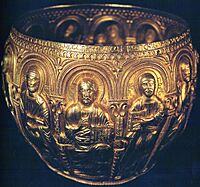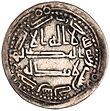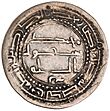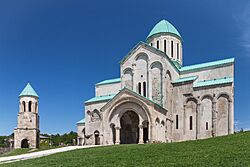Bagrat III of Georgia facts for kids
Quick facts for kids Bagrat IIIბაგრატ III |
|
|---|---|
| King of Georgia | |

Bagrat III, a fresco from the Bedia Cathedral
|
|
| King of Georgia (more...) | |
| Reign | 1008–1014 |
| Predecessor | Unification of the Georgian realm |
| Successor | George I |
| King of Abkhazia | |
| Reign | 978–1008 |
| Predecessor | Theodosius III |
| Successor | Unification of the Georgian realm |
| Duke of Kartli | |
| Reign | 975–978 |
| Predecessor | Gurgen |
| Successor | Gurandukht |
| Born | c. 960 Kutaisi |
| Died | 7 May 1014 (aged 53–54) Panaskerti Castle, Tao |
| Burial | Bedia Cathedral |
| Spouse | Martha |
| Issue | George I of Georgia Basil of Khakhuli? |
| Dynasty | Bagrationi |
| Father | Gurgen of Iberia |
| Mother | Gurandukht of Abkhazia |
| Religion | Georgian Orthodox Church |
Bagrat III (Georgian: ბაგრატ III) (born around 960, died May 7, 1014) was a very important king from the Bagrationi dynasty. He became King of Abkhazia in 978. Later, in 1008, he became King of Georgia. Bagrat was special because he united many different lands. He used both family connections and battles to bring them together. This made him the first true King of a united Georgia. Before becoming king, he also ruled in Kartli with his father, Gurgen, from 976 to 978.
Contents
Early Life and Rule in Kartli
Growing Up and Family
Bagrat was born around the 960s, likely in Kartli. He was the only known son of Gurgen, who was a king in Iberia. His mother was Gurandukht, the daughter of King George II of Abkhazia. This meant Bagrat was an heir to the powerful Bagrationi dynasty.
When Bagrat was young, his father's cousin, David III of Tao, helped raise him. David III was a powerful ruler in the region of Upper Tao. He was also a high-ranking official called a Kouropalates in Iberia.
A Time of Trouble in Georgia
Back then, Iberia was under the control of the Kingdom of Abkhazia. Abkhazia had become a strong kingdom after breaking away from the Byzantine Empire around 780. By 916, it was very powerful, even invading Iberia and threatening Armenia.
However, in 975, King Theodosius III (Bagrat's uncle) became king of Abkhazia. He was known as "the Blind" and had trouble controlling his nobles. This led to a civil war, causing chaos across the country.
Seeing this weakness, Kvirike II of Kakheti, a ruler in eastern Georgia, started attacking Iberia. He even took over eastern Georgia completely. But the governor of Kartli, Ioane Marushisdze, fought back against Kvirike II. He asked for help from Bagrat's adoptive father, David III of Tao.
In 976, David III came to Iberia and defeated the Kakhetians. They had to leave the country. David III then gave the freed kingdom to young Bagrat. Since Bagrat was still young, his father, Gurgen, ruled as a regent for him.
Challenges and Changes in Power
Bagrat III's first time ruling Iberia was short and not much is known about it. Soon after he became ruler, the nobles, who had gained power during the chaos, started to rebel.
In 978, some noble groups joined forces with David, the new prince of Kakheti. They captured the fortress of Uplistsikhe and took Bagrat III and his parents hostage.
When David III of Tao heard this, he marched his army against the Kakhetians. After talks, the Kakhetians gave Iberia back to the royal family. However, they kept two fortresses. From then on, Bagrat's mother, Queen Gurandukht, ruled the kingdom.
Becoming King of Abkhazia
Meanwhile, King Theodosius III in Abkhazia was still weak. The nobles there were causing more problems. Ioane Marushisdze, who had helped Bagrat become ruler of Iberia, now wanted him to rule Abkhazia too.
Ioane Marushisdze and the nobles from both Iberia and Abkhazia agreed. They believed a strong new king was needed to unite the two countries. So, Bagrat III was given the royal symbols and became king. This happened in 978. Bagrat, now in charge of western and central Georgia, sent the old king Theodosius III to live with his adoptive father, David III of Tao.
Dealing with Rebellions
After becoming King of Abkhazia, Bagrat III had to quickly return to Kartli. His mother, Gurandukht, who was ruling there, wanted to become independent. The nobles of Kartli liked ruling with her and refused to accept Bagrat III as their king. They chose a leader named Kavtar Tbeli.
The nobles set up defenses across central Georgia. But Bagrat defeated them in a battle at Moghrisi. He then took back Uplistsikhe from his mother. After stopping this noble rebellion, he went back to Abkhazia. There, he called his mother to him. Bagrat III then worked to bring order to Abkhazia. He calmed the nobles and showed himself to be a fair and honest ruler.
A Family Conflict
A few years later, before 994, a powerful nobleman named Rati, Duke of Kldekari, became very strong in the eastern part of Bagrat III's kingdom. He took control of the fortress of Ateni and other areas. Rati then refused to obey Bagrat III.
Bagrat marched with a large army, joined by his father Gurgen's soldiers, against Rati. However, Bagrat's adoptive father, David III of Tao, worried that Bagrat would become too powerful. So, David III allied with Bagrat's grandfather, Bagrat Regueni, and with Armenian kings. They wanted to stop Bagrat's campaign.
The first battle happened in Gardatkhinlni. Gurgen's army was defeated, and he had to hide in a fortress. King Bagrat III, who had paused his fight against Rati, realized he wasn't strong enough to fight David III of Tao and Bagrat Regueni. He started talking with them to find a peaceful solution. In the end, they made peace, and this "family war" ended.
Bagrat III returned to Abkhazia and ruled peacefully. He let Rati, the rebellious nobleman, go back to his lands. But Bagrat had a plan. He wanted Rati to think the conflict was over. So, during the next winter, Bagrat gathered his troops and attacked Kldekari. He defeated the duke. Rati was forgiven and made Duke of Argveti in western Georgia.
Uniting Georgia
On March 31, 1000, Bagrat III's adoptive father, David III Kuropalates, died. He was likely assassinated. The old Georgian writings say that when David III died, his region of Tao was left empty. The Byzantine emperor Basil II claimed Tao. David had promised it to him because of his help in a past rebellion.
Emperor Basil II expected a difficult fight to take over Tao. However, he found that the local nobles accepted him as their ruler. They did not recognize Bagrat III's authority. In just a few months, Basil II took control of Tao-Klarjeti. He then gave the title of "Magistros" to Bagrat's father, Gurgen. He gave the title of "Kouropalates" to Bagrat himself. Basil II tried to cause conflict between father and son, but it didn't work. Gurgen was known as an honest and good father. So, Bagrat III, already King of Abkhazia, also became Kuropalates of Iberia. This united western Georgia, but he lost some of his family's lands to the Byzantines.
In 1008, Bagrat's father, Gurgen I of Iberia, died. Bagrat then received the title "King of the Georgians" and the united region of Lower Tao-Javakheti. Now, Bagrat III controlled all the lands ruled by his Bagrationi dynasty family members. He decided to expand his rule into eastern Transcaucasia.
He first demanded lands from David, the prince of Kakheti. These were lands David had taken after a war in Kartli in 978. David refused and prepared for war. Bagrat III was angry. He marched into Kakheti, crossed Kartli, and destroyed Hereti, an eastern part of Kakheti. He appointed a local leader, Aboulal, as the ruler of Hereti. But the local nobles overthrew Aboulal and decided to join Kakheti.
When Bagrat III heard about the revolt in Hereti, he gathered his troops and returned to conquer it again. He quickly took over Hereti and brought the local nobles under his control. In 1008, Bagrat III began to conquer Kakheti. He finished this in 1010 with little resistance. He briefly left a fortress to Prince Kvirike III of Kakheti, but later took it back and fully annexed the country. After this war, Bagrat III was the absolute ruler of all Georgia. He had completed the unification of the country. He was now "King of the Abkhazians, Kartvels, Rans and Kakhs."
Wars Against Neighbors
As King of Georgia, Bagrat III decided to attack neighboring countries. He chose to attack the Emirate of Ganja. Its ruler, Fadl ibn Muhammad, had been raiding eastern Georgia. To achieve his goals, Bagrat made an alliance with the Armenian king Gagik I.
In 1012, Armenian and Georgian armies joined forces and marched towards Ganja. Fadl, who had sworn to kill all Christians and had never been defeated, was very surprised. He learned that the armies of two Christian countries were advancing. He hid in a fortress and prepared for a long siege. Bagrat took advantage of this to seize lands in Arran, making it a Georgian province. He then began the Siege of Shamkor, the fortified town where Fadl was hiding. In just a few days, Bagrat broke through the city's defenses. He then offered peace to the defeated ruler. Fadl became a vassal of Georgia. He had to help Bagrat if needed and pay tribute. Fadl gave many rich gifts to the King of Georgia and to the nobles who convinced Bagrat to make peace without fully taking Ganja.
Georgia's Growing Power
After taking control of eastern Transcaucasia, Bagrat III focused on the border with the Byzantine Empire in the southwest. Since 1000, when David III Kuropalates died and left his lands to Byzantium, Tao-Klarjeti had been part of the Byzantine Empire. For a while, Bagrat ruled Lower Tao and Javakheti after his father died. But he still didn't control the lands under Byzantine rule.
However, between 1011 and 1012, Bagrat decided to take back his family's lands. He fought against the princes Sumbat and Gurgen of Klarjeti. These princes had submitted to Byzantium and called themselves "King of Klarjeti," threatening Georgia's power. Bagrat quickly defeated them without any resistance from the Byzantine Empire. In 1012, he had Sumbat and Gurgen killed while they were imprisoned. He allowed their children to go into exile in Constantinople.
Bagrat III had just taken over the duchy of Artanuji. He was now the definite ruler of all Georgian lands. But he didn't stop there. He led campaigns in the Caucasus and brought Arran and Shirvan under his control. According to Georgian records, he also influenced Armenia. He allied with the Abbasid caliph Al-Qadir and became an enemy of Basil II. Under his rule, Georgia was united, and there were no noble revolts. The king held Georgia firmly in his hand, like an absolute ruler. His people also loved him, and the farmers saw themselves as his loyal subjects.
Bagrat and Christianity

With the unification of Georgia, King Bagrat III also helped create the position of Catholicos-Patriarch of All Georgia, which still exists today. Before the 1000s, the Patriarch John IV was called "Catholicos of Iberia."
Bagrat III was a very Christian king. He had several churches built. One was the Bedia Cathedral, built in 999. He made it the main church of a bishopric and the religious capital of Abkhazia. He also built the Bagrati Cathedral in his capital city of Kutaisi. This amazing religious building was finished in 1003. It was a UNESCO World Heritage Site from 1994 until 2017. It was removed because of a big reconstruction project that changed its original look.
According to historians, Emperor Basil II, who didn't have the best relationship with Georgia, offered the Georgian Church a monastery in Greece. At the same time, the Catholicos-Patriarch of All Georgia gained many villages, silver, gold, icons, and crosses to decorate churches. Some historians from the 18th century believed that the Svetitskhoveli Cathedral in Mtskheta, which is now the main church for the Georgian Patriarch, was built or restored under Bagrat III. However, it is now known that this happened during the next king's rule.
Death of a King
After defeating the dukes of Klarjeti, Bagrat III made a final trip through his kingdom. He traveled from Abkhazia to Hereti, passing through Kartli and Kakheti. He finally stopped in Tao, where he spent the winter of 1013-1014 in Panaskerti fortress. This was an old home of the rulers of Tao.
He died on May 7, 1014, in his royal home. He was quite old, with long white hair, and had ruled for thirty-six years. Count Zviad Orbeliani, who ruled a part of Abkhazia, took care of his body. He transported it to the north of the country. The first king of united Georgia was buried in 1014 in the Bedia Cathedral.
The Georgian Orthodox Church recognized him as a saint on December 22, 2016. His feast day is celebrated on May 7 (May 21 in the New Style calendar).
Family Life
According to a genealogist named Cyril Toumanoff, King Bagrat III had a wife named Martha. They had one son, George I of Georgia. Other historical records suggest he had a second child named Basil, who later became known as Basil of Khakhuli and was also recognized as a saint by the Georgian Orthodox Church.
See Also
- Byzantine–Georgian wars
- Divan of the Abkhazian Kings
- History of Georgia
- Tao-Klarjeti
Genealogy
|
|||||||||||||||||||||||||||||||||||||||||||||||||||||||||||||||||||||||||||||||||||||||||||||||||||||||||||||||||||||||||||||||||||||||||||||||||||||||||||||||||||||||||||||||||||||||||||||||||||||||||||||||||||||||||||||||||||||||||||||||||||||||||||||||||||||||||||||||||||||||||||||||||||||||||||||||||||||||||||||||||||||||||||||||||||||||||||||||||||||||||||||||||||||||||||||||||||||||||||||||||||||||||||||||||||||||||||||||||||||||||||||||||||||||||||||||||||||||||||||||||||||||||||||||||||||||||||||||||||||||||||||||||||||||||||||||||||||||||||||||||||||||||||||||||||||||||||||||||||||||||||||||||||||||||||||||||||||||||||||||||||||||||||||||||||||||||||||||||||||||||||||||||||||||||||||||||||||||||||||||||||||||||||||||||||||||||||||||||||||||||||||||||||||||||||||||||||||||||||||||||||||||||||||||||||||||||||||||||||||||||||||||||||||||||||||||||||||||||||||||||||||||||||||||||||||||||||||||||||||||||||||||||||||||||||||||||||||||||||||||||||||||||||||||||||||||||||||||||||||||





